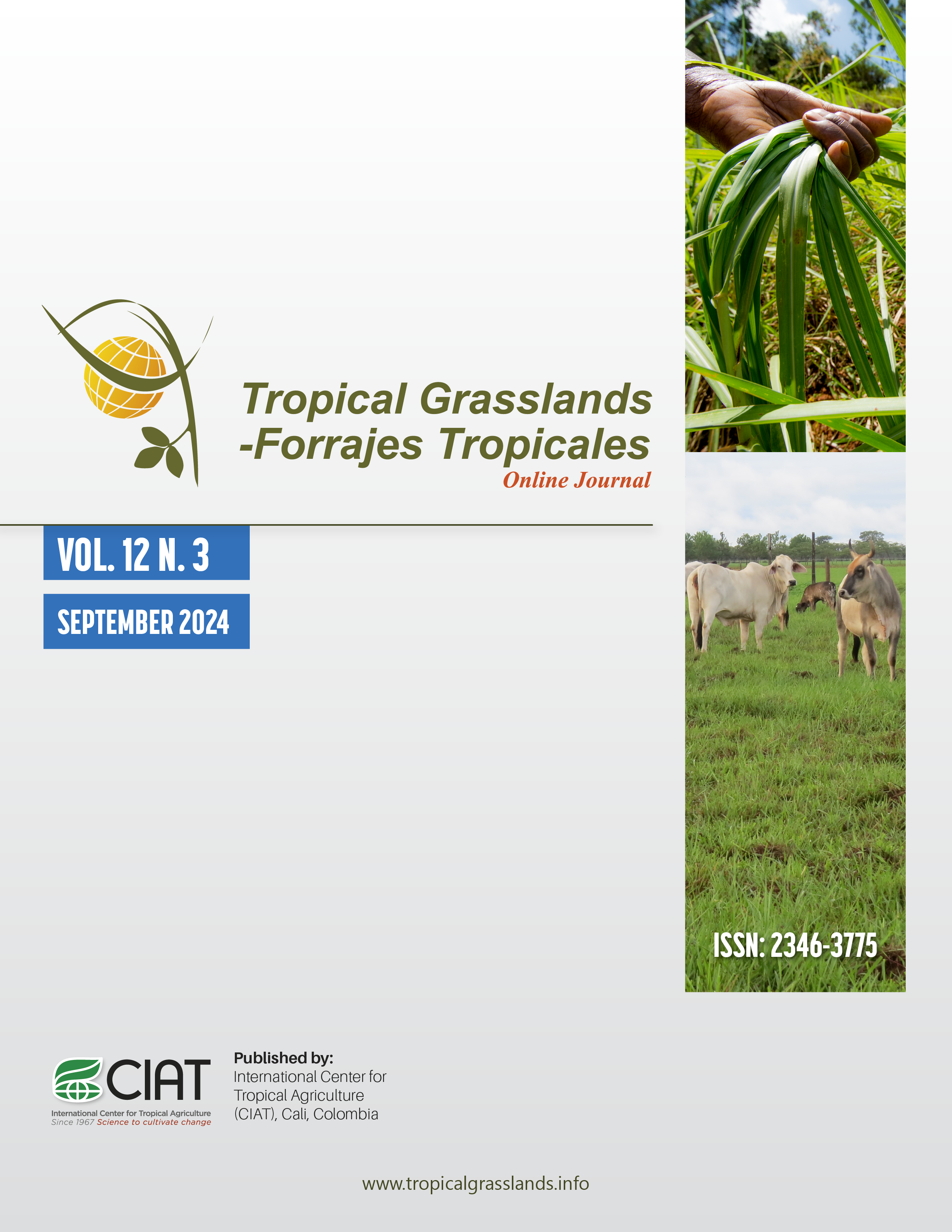Desempeño agronómico y valor nutritivo de las especies de Urochloa, pastos Desho y Rhodes cultivados en en la zona central subhúmeda de Etiopía
DOI:
https://doi.org/10.17138/tgft(12)154-161Resumen
Las gramíneas forrajeras mejoradas con alta calidad y biomasa son una fuente adicional de alimento crucial para la ganadería de cereales en Etiopía. Este estudio comparó el desempeño de 4 especies de Urochloa [U. brizantha (DZF-13379), U. humidicola (DZF-9222), U. decumbens 'Basilisk' (DZF-10871) y U. mutica (DZF-483)] con otras 2 gramíneas comúnmente utilizadas, la hierba Rhodes (Chloris gayana 'Massaba') y la hierba Desho (Pennisetum glaucifolium variedad local Kindu kosha), durante 3 años durante la temporada principal de lluvias en Bishoftu, en una zona subhúmeda de Etiopía. El experimento se realizó utilizando un diseño de bloques completos al azar. Hubo una variación significativa entre las especies en cuanto a los parámetros agronómicos. La interacción especie × año fue significativa para el rendimiento de materia seca, altura de la planta y cobertura, pero no fue significativa para la relación hoja/tallo. El valor nutricional [cenizas, fibra detergente ácida (FDA), proteína cruda (PC) y digestibilidad in vitro de la materia seca (DIVMS)] fue significativamente diferente entre las especies, sin diferencias para la fibra detergente neutra (FND) y la lignina detergente ácida (LDA). Todas las especies mostraron potencial como alimento alternativo para rumiantes, siendo U. mutica y U. brizantha las de mayor rendimiento en el ambiente subhúmedo.
Referencias bibliográficas
Arango J; Moreta D; Núñez J; Hartmann K; Domínguez M; Ishitani M; Miles J; Subbarao G; Peters M; Rao I. 2014. Developing methods to evaluate phenotypic variability in biological nitrification inhibition (BNI) capacity of Brachiaria grasses. Tropical Grasslands-Forrajes Tropicales 2(1):6–8. doi: 10.17138/tgft(2)6-8
Asmare B; Demeke S; Tolemariam T; Tegegne F; Haile A; Wamatu J. 2017. Effects of altitude and harvesting dates on morphological characteristics, yield and nutritive value of desho grass (Pennisetum pedicellatum Trin.) in Ethiopia. Agriculture and Natural Resources 51(3):148–153. doi: 10.1016/j.anres.2016.11.001
Assefa G; Mengistu S; Feyissa F; Bediye S. 2016. Animal feed resources research in Ethiopia: Achievements, challenges and future directions. Ethiopian Journal of Agricultural Sciences special issue:141–155.
Bantihun A; Asmare B; Mekuriaw Y. 2022. Comparative evaluation of selected grass species for agronomic performance, forage yield, and chemical composition in the highlands of Ethiopia. Advances in Agriculture 2022(1):6974681. doi: 10.1155/2022/6974681
Bates D; Mächler M; Bolker B; Walker S. 2015. Fitting linear mixed-effects models using lme4. Journal of Statistical Software 67(1):1–48. doi: 10.18637/jss.v067.i01
Cezário AS; Ribeiro KG; Santos SA; Valadares Filho SC; Pereira OG. 2015. Silages of Brachiaria brizantha cv. Marandu harvested at two regrowth ages: Microbial inoculant responses in silage fermentation, ruminant digestion and beef cattle performance. Animal Feed Science and Technology 208:33–43. doi: 10.1016/j.anifeedsci.2015.06.025
Cheruiyot D; Midega CAO; Pittchar JO; Pickett JA; Khan ZR. 2020. Farmers’ perception and evaluation of Brachiaria grass (Brachiaria spp.) genotypes for smallholder cereal-livestock production in East Africa. Agriculture 10(7):268. doi: 10.3390/agriculture10070268
Cheruiyot D; Midega CAO; Ueckermann EA; Van den Berg J; Pickett JA; Khan ZR. 2018. Genotypic response of brachiaria (Urochloa spp.) to spider mite (Oligonychus trichardti) (Acari: Tetranychidae) and adaptability to different environments. Field Crops Research 225:163–169. doi: 10.1016/j.fcr.2018.06.011
Damene S; Bahir A; Villamor GB. 2020. The role of Chomo grass (Brachiaria humidicola) and enclosures in restoring soil organic matter, total nitrogen, and associated functions in degraded lands in Ethiopia. Regional Environmental Change 20(3):92. doi: 10.1007/s10113-020-01680-z
Faji M; Kebede G; Feyissa F; Mohammed K; Mengistu G. 2022. Yield, yield components, and nutritive value of perennial forage grass grown under supplementary irrigation. Advances in Agriculture 2022(1):5471533. doi: 10.1155/2022/5471533
FAO (Food and Agriculture Organization of the United Nations). 2018. Ethiopia: Report on feed inventory and feed balance. Rome, Italy. 160 pages. openknowledge.fao.org
Feyissa F; Kebede G; Geleti D; Assefa G; Mengistu A. 2022. Improved forage crops research and development in Ethiopia: Major achievements, challenges and the way forward. OMO International Journal of Sciences 5(2):36–69. doi: 10.59122/135BE51
Habte M; Eshetu M; Maryo M; Andualem D; Legesse A. 2022. Effects of climate variability on livestock productivity and pastoralists perception: The case of drought resilience in Southeastern Ethiopia. Veterinary and Animal Science 16:100240. doi: 10.1016/j.vas.2022.100240
Horrocks CA; Arango J; Arevalo A; Nuñez J; Cardoso JA; Dungait JAJ. 2019. Smart forage selection could significantly improve soil health in the tropics. Science of The Total Environment 688:609–621. doi: 10.1016/j.scitotenv.2019.06.152
Lenth RV. 2016. Least-Squares Means: The R Package lsmeans. Journal of Statistical Software 69(1):1–33. doi: 10.18637/jss.v069.i01
Lonsdale C. 1989. Straights: Raw materials for animal feed compounders and farmers. Chalcombe Publications, Great Britain. p. 17–47. ISBN 10: 0948617152
Maina KW; Ritho CN; Lukuyu BA; Rao EJO. 2020. Socio-economic determinants and impact of adopting climate-smart Brachiaria grass among dairy farmers in Eastern and Western regions of Kenya. Heliyon 6(6):e04335. doi: 10.1016/j.heliyon.2020.e04335
Mekonnen K; Bezabih M; Thorne P; Gebreyes MG; Hammond J; Adie A. 2022. Feed and forage development in mixed crop–livestock systems of the Ethiopian highlands: Africa RISING project research experience. Agronomy Journal 114(1):46–62. doi: 10.1002/agj2.20853
Mengistu G; Faji M; Mohammed K; Workiye M; Kebede G; Terefe G; Dejene M; Feyissa F. 2024. Forage yield and nutritive value of Desho grass (Pennisetum glaucifolium Trin.) as affected by cutting heights in the central highlands of Ethiopia. Heliyon 10(7):e28757. doi: 10.1016/j.heliyon.2024.e28757
Midega CAO; Pittchar JO; Pickett JA; Hailu GW; Khan ZR. 2018. A climate-adapted push-pull system effectively controls fall armyworm, Spodoptera frugiperda (J E Smith), in maize in East Africa. Crop Protection 105:10–15. doi: 10.1016/j.cropro.2017.11.003
Miles JW; Do Valle CB; Rao IM; Euclides VPB. 2004. Brachiaria grasses. In: Moser LE; Burson BL; Sollenberger LE, eds. Warm-Season (C4) Grasses. Agronomy Monograph 45 American Society of Agronomy, Crop Science Society of America, and Soil Science Society of America, Madison, WI. p. 745–783. doi: 10.2134/agronmonogr45.c22
Moreta DE; Arango J; Sotelo M; Vergara D; Rincón A; Ishitani M; Castro A; Miles J; Peters M; Tohme J; Subbarao GV; Rao IM. 2014. Biological nitrification inhibition (BNI) in Brachiaria pastures: A novel strategy to improve eco-efficiency of crop-livestock systems and to mitigate climate change. Tropical Grasslands-Forrajes Tropicales 2(1):88–91. doi: 10.17138/TGFT(2)88-91
Ndayisaba PC; Kuyah S; Midega CAO; Mwangi PN; Khan ZR. 2020. Push-pull technology improves maize grain yield and total aboveground biomass in maize-based systems in Western Kenya. Field Crops Research 256:107911. doi: 10.1016/j.fcr.2020.107911
Rao I; Ishitani M; Miles J; Peters M; Tohme J; Arango J; Moreta DE; Lopez H; Castro A; Van der Hoek R; Martens S; Hyman G; Tapasco J; Duitama J; Suárez H; Borrero G; Núñez J; Hartmann K; Domínguez M; Sotelo M; Vergara D; Lavelle P; Subbarao GV; Rincon A; Plazas C; Mendoza R; Rathjen L; Karwat H; Cadisch G. 2014. Climate-smart crop-livestock systems for smallholders in the tropics: Integration of new forage hybrids to intensify agriculture and to mitigate climate change through regulation of nitrification in soil. Tropical Grasslands-Forrajes Tropicales 2(1):130–132. doi: 10.17138/TGFT(2)130-132
Tafesse D; Esayas A. 2003. Soils of Debre Zeit Agricultural Research Center and its sub-centers Technical Paper No 79. Ethiopian Agricultural Research Organization, Ethiopia. bit.ly/4gmIxwY
Tilley JMA; Terry RA. 1963. A two-stage technique for the in vitro digestion of forage crops. Grass and Forage Science 18(2):104–111. doi: 10.1111/j.1365-2494.1963.tb00335.x
Van Soest PJ. 1994. Nutritional ecology of the ruminant. 2nd Edition. Cornell University Press, Cornell, USA. 476 p.
Van Soest PJ; Robertson JB. 1985. Analysis of forages and fibrous foods. CRC-Press.
Wassie WA; Tsegay BA; Wolde AT; Limeneh BA. 2018. Evaluation of morphological characteristics, yield and nutritive value of Brachiaria grass ecotypes in northwestern Ethiopia. Agriculture and Food Security 7(1):89. doi: 10.1186/s40066-018-0239-4
Cómo citar
Descargas
Descargas
Publicado
Número
Sección
Licencia
Derechos de autor 2024 Tropical Grasslands-Forrajes Tropicales

Esta obra está bajo una licencia internacional Creative Commons Atribución 4.0.




